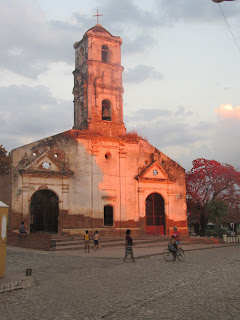 |
| The attractive tower with an ugly history |
Our first stop, about an hour from Trinidad, was at Manaca Iznaga in the Valle de los Ingenios, now a UNESCO world heritage site for its beautiful natural scenery, the ruins of sugar mills and slaves quarters and the fading, elegant haciendas of the early mill owners. It was from the dozens of sugar cane plantations in this valley that Trinidad gained most of its wealth in the 19th century. There is still some sugar cane grown here however most of the mills were destroyed in the War of Independence and the Spanish-Cuban-American war of 1895 to 1898. Plantation owners moved to other parts of Cuba but over time the sugar industry has declined and is now merely a shadow of what it once was.
 |
| View from the tower of the linen market and slave owner's hacienda |
The Manaca Iznaga plantation was bought by Pedro Iznaga in 1795, a ruthless man he became extremely wealthy through slave trafficking. Today the plantation is a peaceful place. A linen market, displaying exquisite hand embroidered, snowy white, table cloths, clothing and bed linen, lines the entry to the spectacular 44 metre high tower which overlooks the estate. We climbed the tower to drink in the panoramic views over the surrounding countryside whilst learning of its ugly history as a watchtower to oversee the plantation slaves, make sure they worked hard and didn't escape. Sobering to say the least.
 |
| The linen is all hand embroidered. I bought beautiful dresses for my grand daughters and a snowy white table cloth |
 |
| Che Guevera's mausoleum, no photos are allowed inside. Note the size of the people walking by |
 |
| The only type of billboards you ever see in Cuba |
We finally arrived in Havana after a 4 hour drive through flat, fairly featureless countryside mesmerised by the lolling head of our guide as he gently dozed for much of the trip. Well, there was one feature and that was the number of burnt out or burning cars we saw along the highway. It seems keeping those old cars on the road can be a risky business. It wouldn't surprise me if they were successfully repaired to drive another day. Needs must!
As we drove into a busy Havana our guide proudly pointed out the stadium the Rolling Stones had performed at during their visit to Cuba. It was clearly a big deal. As luck would have it I found the video of the Rolling Stones concert, Havana Moon, on the plane as I flew home. What a fantastic concert, if you get the chance, watch it.
Late in the day we arrived back in the heart of Havana. It's always good to come back to somewhere familiar and there was still some sightseeing to do.



















